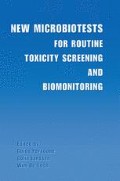Abstract
In recent years there has been increasing development of methods (particularly rapid tests) for testing environmental samples. If appropriate methods are to be used for a particular operational role then it is necessary to adopt a robust and objective selection mechanism. This paper describes the application of a criteria-based procedure to the selection of test batteries of methods for use in effluent testing. In the procedure tests are scored against a series of criteria with the exact criteria used depending on the operational role and form of test (for example rapid or conventional). Examples of criteria used include: previous application of a method to an operational role, discrimination between samples, influence of physico-chemical parameters, ease of use, test duration, test costs, test capability (sensitivity and spectrum of response) test precision (repeatability and reproducibility), availability of a standard operating procedure, availability of test organisms, test organism variability, the use of indigenous test organisms, importance of test organisms, the relationship between the data for rapid and conventional tests and the ecological relevance of test endpoints. To ensure each method is assessed in a consistent way test scores are assigned using defined guidelines and for certain criteria methods have to satisfy a threshold requirement otherwise they are not deemed to be suitable for the intended purpose. The use of the procedure has been demonstrated by considering the suitability of a series of Toxkits and, where appropriate, their conventional counterparts for effluent assessment.
Access this chapter
Tax calculation will be finalised at checkout
Purchases are for personal use only
Preview
Unable to display preview. Download preview PDF.
References
Biesinger K.E. and Christensen G.M. 1972. Effects of various heavy metals on survival, growth, reproduction and metabolism of Daphnia magna. J.Fish.Res.Bd.Can. 29:1691–1700.
CCREM 1987. Canadian Water Quality Guidelines. Inland Water Directorate, Environment Canada, Ottawa, Canada.
Dixon D.G. and Leduc G. 1981. Chronic cyanide poisoning of rainbow trout and its effects on growth, respiration and liver histopathology. Arch.Environ.Contam. Toxicol. 10(1): 117–131.
Dortland J.R. 1980. Toxicological evaluation of parathion and azinphos-methyl in freshwater model ecosystems. Centre for Agricultural Publishing and Documentation, Wageningen, The Netherlands.
Environment Agency 1996. The application of toxicity-based criteria for the regulatory control of wastewater discharges. Environment Agency Consultation Report, Environment Agency, Bristol, UK, pp 50.
Environment Canada 1990. Guidance document on control of toxicity test precision using reference toxicants. Environment Canada Report EPS l/RM/12. Environmental Protection Series, Environment Canada, Ottawa, Canada.
Geyer H., Scheunert I. and Korte F. 1985. The effects of environmental chemicals on the growth of the alga Scenedesmus subspicatus. A contribution to environmental biology. Chemosphere 14:1355–1369.
Hill I.R., Matthiessen P. and Heimbach F. 1993. Guidance document on sediment toxicity tests and bioassays for freshwater and marine environments. Society of Environmental Toxicology and Chemistry—Europe Report from the Workshop on Sediment Toxicity Assessment, Renesse, The Netherlands, pp 105.
Janssen C. 1998. Alternative assays for routine toxicity assessments: A Review. In Schuurmann G. and Markert B., eds, Ecotoxicology. J Wiley and Sons, London, UK, pp 813–839.
Johnson I. 1995. Identification of screening, lethal and sub-lethal toxicity tests for assessing effluent toxicity. NRA R&D Note 389. National Rivers Authority, Bristol, UK.
Johnson I. and Holmes D. 1997. Toxicity-based consents pilot study. Environment Agency Project Record P2-493/11. Environment Agency, Wallingford, UK.
Kuhn R., Pattard M., Pernak K.D. and Winter A. 1989. Results of harmful effects of selected water pollutants (anilines, phenols, aliphatic compounds) to Daphnia magna. Water Res. 23(4):95–499.
MAFF 1990.Utility of experimental measures of biological effects for monitoring marine sewage sludge disposal sites. Aquatic Environment Monitoring Report Number 24, Ministry of Agriculture, Fisheries and Food, London, UK.
Macek K.J., Lindberg M.A., Sauter S., Buxton K.S. and Costa P.A. 1976. Toxicity of four pesticides to water fleas and fathead minnows. Acute and chronic toxicity of acrolein, heptachlor, endosulphan and trifluralin to the water flea (Daphnia magna) and the fathead minnow (Pimephales promelas). Report EPA-600/3-76/009. Office of Research and Development, United States Environmental Protection Agency, Cincinnati, Ohio, USA.
McCarty L.S. and Mackay D. 1993. Enhancing ecotoxicological modelling and assessment. Environ.Sci.Technol. 27(9):1719–1728.
Nebeker A.V., McCrady J.K., Mshar R. and McAuliffe C.K. 1983. Relative sensitivity of Daphnia magna, rainbow trout and fathead minnows to endosulphan. Environ.Toxicol.Chem. 1:69–72.
Okkerman P.C., van der Plassche E.J., Sloof W., van Leeuwen C.J. and Canton J.H. 1991. Ecotoxicological effects assessment. A comparison of several extrapolation procedures. Ecotox.Environ.Safe. 21:182–193.
Persoone G. 1998a. Development and first validation of a“stock-culture free”algal microbiotest: The Algaltoxkit. In Wells P.G., Lee K. and Blaise C., eds, Microscale testing in aquatic toxicology. CRC Press, pp 437–449.
Persoone G. 1998b. Development and validation of toxkit microbiotests with invertebrates, in particular crustaceans. In Wells P.G., Lee K. and Blaise C., eds, Microscale testing in aquatic toxicology. CRC Press, pp 311–320.
Rodrigue D., Mailhiot K., Hynes T.P. and Wilson L.J. 1995. Aquatic effects monitoring in the mining industry: review of appropriate technologies. In Hynes T.P. and Blanchette M.C., eds, Proceedings of Sudbury 95-Mining and the Environment, pp 813–819.
US.EPA 1991. Technical support dDocument for water quality-based toxics control. United States Environmental Protection Agency EPA/505/2-90-001, Office of Water, Washington DC, USA.
Verschueren K. 1983. Handbook of environmental data on organic chemicals, 2nd Edition. Van Nostrand, New York.
Widdows J. and Donkin P. 1992. Mussels and environmental contamination: Bioaccumulation and Physiological Aspects. In Gosling E., ed, The mussel Mytilus, Physiology, Genetics and Culture. Elsevier Publishing, Amsterdam, pp 383–424.
Author information
Authors and Affiliations
Editor information
Editors and Affiliations
Rights and permissions
Copyright information
© 2000 Springer Science+Business Media New York
About this chapter
Cite this chapter
Johnson, I. (2000). Criteria-based procedure for selecting test methods for effluent testing and its application to Toxkit microbiotests. In: Persoone, G., Janssen, C., De Coen, W. (eds) New Microbiotests for Routine Toxicity Screening and Biomonitoring. Springer, Boston, MA. https://doi.org/10.1007/978-1-4615-4289-6_7
Download citation
DOI: https://doi.org/10.1007/978-1-4615-4289-6_7
Publisher Name: Springer, Boston, MA
Print ISBN: 978-1-4613-6924-0
Online ISBN: 978-1-4615-4289-6
eBook Packages: Springer Book Archive

